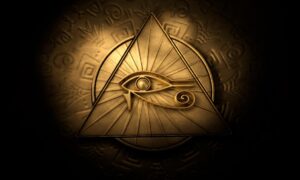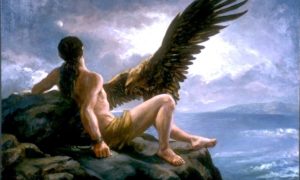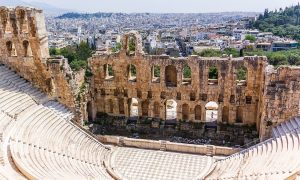Greek history and culture are rich with incredible tales of people with superhuman powers and terrifying monsters. We know all about the Gods who were said to live on Mount Olympus, headed by Zeus. All of us have heard of Hercules and his almighty strength, and Jason and his Argonauts. We’re told all these stories when we’re in school, and for many of us, they represent our happiest memories of history class.
This article isn’t about the Gods and heroes of Ancient Greece, though. We’re going to be taking a look at the other side of the fence. For every hero or mighty warrior, there has to be a villain. No heroic quest is complete without a monster or a terrifying creature to defeat, and Greek mythology has plenty of them! From the very well known to the barely heard of, here are our top five all-time favorite monsters from the legends of ancient Greece.
Typhon
Where else could we possibly start but with Typhon? This fearsome beast is, after all, nicknamed ‘The Father of All Monsters.’ That’s an impressive title, but based on the descriptions of this creature in ancient Greek texts, he’s worthy of it. His birth was the product of a union between Gaia – the Earth itself – and Tartarus, which is the name given to the deepest and most unpleasant reaches of Hades. How such a union is physically or biologically possible is a big question, but we’ll let that slide for now. The point is that Typhon was as big and terrifying a monster as you could ever imagine.
He was said to be so tall that his head reached the stars in the sky. To make matters worse, his body was made from two coiled snakes, and he had dragon heads where his fingers ought to be. That ought to be more than enough terror for anyone, but the creators of this myth decided to go further with their description. He had wings, could fly, and could also shoot flames out of his eyes. Legend has it that he was eventually defeated by Zeus and imprisoned in Tartarus (so basically sent back to his father), but his rage and torment manifests itself in earthquakes and volcanoes.
Hydra
What’s worse than a colossal, angry snake? That’s right – a colossal, angry snake with multiple heads. Not only were the hydra’s heads numerous, but they were also seemingly infinite. If you chopped one of them off, two more would grow back to replace it. The same went for its tail. While it could easily have coiled around you and crushed you to death, the hydra’s preferred method for disposing of humans was to breathe on them. Its venom was so deadly that just one single breath was enough to kill a man. We don’t know what would have happened if it bit you, but we’re guessing it wouldn’t be good.
Despite being seemingly immortal, the hydra was killed by Hercules as the second task of his twelve great labors. He got around the problem of its regenerating heads by immediately cauterizing the creature’s neck wounds with a flaming torch each time he lopped one of them off. Meanwhile, he got around the ‘deadly breath’ issue by covering his face with a cloth mask. Maybe that venom wasn’t so deadly after all.
The Minotaur
Apparently, the ancient Greeks thought that being trapped in an incredibly complex labyrinth that you might never escape from wasn’t a scary enough prospect, so they decided to put a monster right in the middle of it and have it hunt you down. That monster was the Minotaur. Considering that the combination of an impossible maze and flesh-eating creature ought to be a terrifying pairing, it’s odd that the Minotaur is looked upon so fondly by so many works of fiction.
There’s so much fascination with the tale that some historians have speculated whether the labyrinth might really have existed under the Palace of Knossos in Crete, although there’s little evidence to support the idea.
With its muscular human torso and bullhead, the Minotaur’s job was to eat the Athenians released into the labyrinth by King Minos. The King was very angry that his son was murdered in Athens, so he took his revenge by sending fourteen Athenians to their doom in the maze every year. The story says that this gruesome practice only came to an end when Theseus managed to solve the riddle of the maze, found the Minotaur sleeping at its center, and killed it before it could wake up.
Polyphemus
If the name “Polyphemus” doesn’t ring any bells, perhaps the term “cyclops” will. The cyclops wasn’t just one creature but a whole race of them – a species of one-eyed giants that had been born from Gaia, which appears to be a recurring theme in Greek mythology. Every cyclops was enormously powerful, so Zeus’s decision to release them from the underworld into the real world was probably a questionable one.
The most famous cyclops was Polyphemus, who briefly captured Odysseus in a cave during the legendary figure’s fabled travels. Each day, he eats one of Odysseus’s crew. Deciding that this wasn’t the way he wanted to go out, Odysseus got the cyclops drunk, stabbed him in the eye when he passed out, and then escaped by tying himself to the underside of one of Polyphemus’s sheep. It’s one of the most entertaining stories in all of Greek folklore.
Medusa
You had to know that this was coming. Of all the monsters that ancient Greece invented, Medusa is the most famous. She’s been immortalized in dozens of songs, movies, and even games at online slots websites such as DoveCasino.com. Titles like “Medusa Megaways,” “Medusa’s Gaze,” and “Medusa Strike” are all popular with online slots players, which is a strange thing for a villain. She’s not the only ancient Greek figure to turn up on the reels of online slots – Zeus is there too – but Zeus is more understandable because he’s a hero. You wouldn’t necessarily have thought that ‘bad guys’ sell online slots games, but there are so many of them that it must be true.
Most of you won’t need us to explain what Medusa was or what she did, but for those who haven’t heard the legend, just know this. She had snakes for hair, and one look at her would turn you to stone. Accounts of her appearance vary – one version of the tale says she was the daughter of the sea God Ceto and had a serpent’s tail, while another says she was actually quite beautiful (if you ignored the snakes), and basically human in appearance. We suppose it’s hard to get a reliable description if everyone who looks at her immediately becomes petrified. Perseus eventually beheaded Medusa after using her reflection in his shield to aim his sword at her. All wasn’t lost, though – Pegasus, the winged horse, emerged from her neck and became a whole new legend.

















